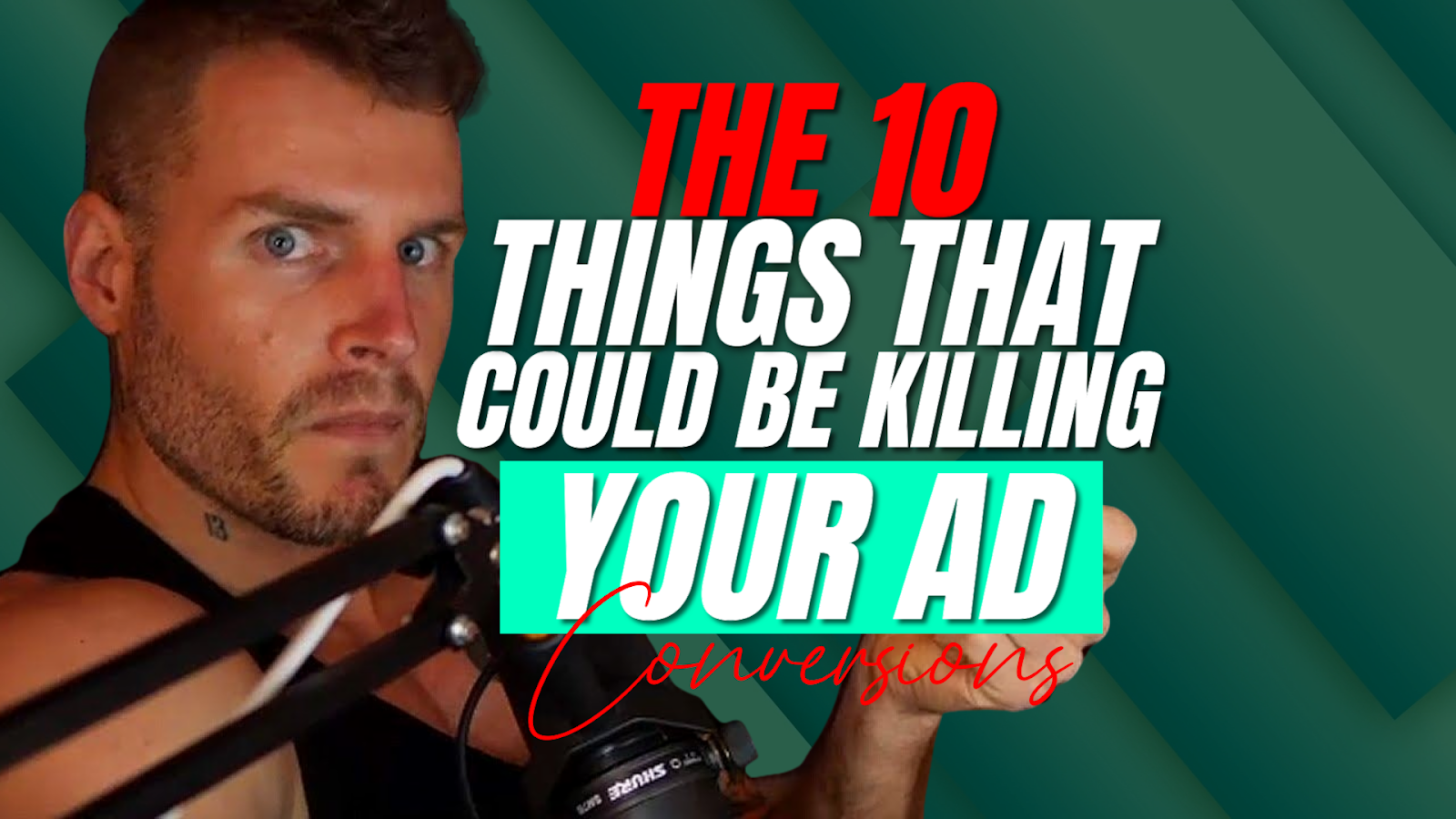
The 10 Things That Could Be Killing Your Ad Conversions
Ad conversions are critical for the success of any business’s advertising efforts. However, despite spending large sums of money on advertising, many businesses struggle to achieve their desired conversion rates. If you own a business, you might commit certain errors that could negatively impact your ad conversions.
In the following write-up, we will discuss ten common mistakes that can reduce your ad conversions and suggest ways to fix them using examples. From a lack of clear call-to-action to poor landing pages, we’ll cover various issues that can impact your ad performance. Once you address these issues, you will see an improvement in your ad conversions, leading to more successful advertising campaigns.
1. Lack of Clear Call-to-Action (CTA)

In the world of advertising, nothing is more crucial than a clear call-to-action (CTA). Without one, your audience may wonder what to do next, resulting in missed opportunities and lower conversion rates.
A well-crafted CTA provides direction to your audience and can be the key to driving engagement and boosting your overall SEO. By enticing your audience to take action, CTAs help create a deeper level of engagement, which search engines favor when determining online rankings.
However, not all CTAs are created equal. They need to be clear, concise, and personalized to your audience to be effective. Generic and vague CTAs can leave your audience feeling uncertain about what action to take, ultimately leading to missed leads and sales.
Crafting a strong CTA that speaks directly to your audience can be the difference between a mediocre advertising campaign and a highly successful one. Whether it’s an offer for a free trial or a discount on their next purchase, a well-designed CTA can encourage your audience to take the next step toward conversion.
Don’t let a lack of direction be the reason why your ad campaign is failing. Take the time to understand your audience and create personalized CTAs that empower them to take action. With the right CTA, you can turn passive viewers into loyal customers and propel your brand to new heights of success.
Moreover, by driving engagement through effective CTAs, your website will rank higher on search engine results pages (SERPs). A clear and personalized CTA can encourage visitors to stay on your page longer, ultimately reducing bounce rates and increasing the likelihood of lead generation.
In conclusion, crafting a clear and targeted CTA is a crucial aspect of modern advertising. It helps your audience understand what action to take and drives engagement while boosting overall SEO. So, take the time to create a strong CTA that empowers your audience to take action today!
2. Poor website design

Poor website design is one of the biggest killers of ad conversions. If your website is poorly designed, it can cause visitors to leave immediately, leading to decreased conversion rates. A poorly designed website can be cluttered, unorganized, and difficult to navigate, frustrating visitors and making them less likely to convert.
The good news is that there are several tips to help improve your website’s design and ultimately boost conversion rates. Start by ensuring your website is visually appealing and easy to navigate. Use high-quality images and videos to engage users and ensure your website is mobile-friendly.
Simplify the design using clean layouts and fonts to make it easy to understand your message. Use whitespace effectively to create a clean and modern look. Finally, ensure that your call-to-action buttons are prominent, easy to find, and clearly communicate what you want your visitors to do.
By implementing these website design tips, you can optimize your website for better conversions and ultimately increase revenue. Don’t let a poorly designed website be the reason for missed opportunities.
3. Not targeting the right audience
Not targeting the right audience is a surefire way to kill your ad conversions. Your message will be lost in the noise if you’re not speaking to the right people. Even the most creative ad can be rendered ineffective if it’s not reaching the right eyes and ears.
To target the right audience, you need to know who they are. It’s essential to do your research and understand your audience’s demographics, interests, and behaviors. Once you know who you’re targeting, you can create messaging that speaks directly to them.
Another essential tip is to use data to inform your targeting. Platforms like Facebook and Google allow you to target users based on various factors, from age and location to interests and behaviors. This data can help you reach the right people and increase your conversions.
Finally, it’s essential to test and iterate. Be sure to track your ad’s performance and make adjustments as needed. Testing different audiences, messaging, and formats can help you find the winning formula for your ads.
In conclusion, targeting the right audience is essential for ad conversions. You can increase your chances of success by doing your research, using data to inform your targeting, and testing and iterating.
4. Slow loading speed

Are your ad conversions suffering? Do you find yourself scratching your head, trying to figure out why clicks aren’t turning into sales? It’s time to examine loading speed. Slow loading times can cause potential customers to lose interest and leave before seeing your offer, ultimately damaging your bottom line.
But fret not, there are ways to improve loading speed and increase conversions. The first step is to optimize images and videos by reducing their file size. Simplifying your website design to reduce clutter and excess code is also recommended. Consider using a content delivery network to ensure faster loading times. Finally, test your website speed frequently to ensure peak performance.
By improving loading speed, you create a better user experience for potential customers, increasing the likelihood of converting them into loyal customers. Don’t let slow loading speed kill your conversions. Address the issue head-on and create a seamless user experience that will keep your customers returning for more.
Loading time has become a crucial factor in digital marketing success. The slow loading speed can result in lower conversion rates and lost revenue. Improve your website’s loading speed, and watch your conversions soar!
In today’s fast-paced world, people are looking for quick and easy solutions. A slow website or landing page does not offer this – it signals to the user that they will have to wait and ultimately miss out on what they are looking for. Don’t let slow loading speed be the reason why potential customers lose sight of your offer.
Optimizing your website and landing page’s loading speed is no longer just a nice-to-have, it’s a necessity. The importance of fast loading speed cannot be overstated. It’s time to take action and ensure your website is optimized for speed.
A slow website can cause your customers to think less of your brand. A good digital experience is expected today; a slow-loading website simply does not cut it. By prioritizing loading speed, you’re not only improving your SEO and increasing conversions, but you’re also solidifying your brand’s reputation.
Remember, your website’s loading speed is the first factor in customer engagement – it’s the first impression someone has of your brand. You want to make sure it’s a good one. Take action today and optimize your website for improved loading speed. It’s the first step in creating a memorable and engaging digital experience for your customers.
5. Weak Headline

When it comes to capturing the reader’s attention, few things are as effective as a powerful headline. It’s the secret weapon in the advertising industry, the gateway to the meat and bones of the content. Without one that’s strong and compelling, visitors to your website are likely to lose interest and click away after only a cursory glance.
Lacking a good headline could spell disaster for your ad conversions, making it all the more essential to get it right. A weak or generic headline fails to resonate with the reader, making them less likely to read further. On the other hand, an effective headline is specific, clear, and relevant to the reader’s needs. It draws them in, using strong action words and creating a sense of excitement or urgency.
Consider the difference between a run-of-the-mill headline like “Tips to be More Productive” and one that packs more punch – “10 Easy Ways to Boost Your Productivity in Just One Day”. The latter exudes a sense of practicality, urgency, and excitement that’s far more likely to grab the reader’s attention and lead to better conversions.
There are no hard and fast rules when it comes to crafting the perfect headline, but there are certainly some tried and true methods that have worked in the past. A good way to create an attention-grabbing headline is to focus on the benefits the reader will derive from your content. Look at your product or service through the reader’s lens, and identify what will make them sit up and take notice.
Another way to polish your headlines is to include relevant keywords in them. This improves your SEO, leading to higher visibility and greater online traction. Keywords can help you get discovered more easily by search engines and drive more traffic to your website, creating a virtuous cycle of engagement and better results.
Ultimately, crafting the perfect headline comes down to honing your skills through practice and experimentation. Keep your writing clean and clear, making every word count. Hemingway’s famous dictum to write in short sentences is especially valuable in crafting headlines that pack a punch. Most importantly, have fun with it and stay committed to creating content that engages your audience and empowers them to live their best lives. Remember, engagement is the new SEO, and a killer headline is the first step to getting there.
6. Irrelevant Ad Copy
Ad copy is the text that appears in your ad. It’s the written message that you want your audience to see and take action on.
Irrelevant ad copy can be one of the things that could be killing your ad conversions. If your ad copy does not match the needs and desires of your target audience, then they will simply ignore it.
Effective ad copy speaks directly to the needs and wants of your target audience. It’s clear, concise, and compelling. It grabs your audience’s attention and motivates them to take action. For example, using language like “limited time offer” or “exclusive deal” can create a sense of urgency and encourage conversions.
7. Lack of mobile optimization
If you’re wondering why your ad conversions are low, one of the things you should look into is your mobile optimization. With more and more people using their mobile devices to browse the internet, it’s crucial that your website and ads are optimized for mobile. If they’re not, your potential customers will have a frustrating experience navigating your site and likely leave without converting.
To optimize for mobile, first, ensure that your website is mobile-friendly. This means that it’s responsive and adjusts to fit different screen sizes. Next, make sure that your ads are also optimized for mobile. Use shorter headlines and descriptions that are easy to read on smaller screens. Finally, consider using mobile-specific ad formats like Facebook’s carousel ads or Google’s AMP ads.
By optimizing for mobile, you’ll not only improve your ad conversions, but you’ll also provide a better user experience for your potential customers. So don’t let lack of mobile optimization be the thing that’s killing your conversions – take action now to optimize for mobile and see the results for yourself.
8. Low-Quality Images or Videos

Visual content is crucial in capturing the attention of your audience and driving conversions. Unfortunately, low-quality images or videos can be detrimental to the success of your ad campaign. If you want to make a strong impression and stand out from the crowd, you need to prioritize high-quality visual content.
Think about it: would you be more likely to engage with an ad that features pixelated images or blurry videos? Or would you be more drawn to an ad with crisp, clear visuals that grab your attention?
Your visual content should be of the highest quality to make an impact. Use examples of high-quality images and videos to guide your creative process. This could include stunning product shots, engaging lifestyle imagery, or eye-catching animations that really bring your brand to life.
Remember, your audience is bombarded with ads every day. In order to truly stand out, you need to offer something visually captivating and memorable. Investing in high-quality visual content ensures that your ads are more effective and help drive conversions for your business.
9. Poor Landing Pages
Are your ad conversions struggling? One of the culprits could be your landing page. A landing page is a dedicated web page visitors visit after clicking an ad. It’s a crucial component of any successful advertising campaign because it’s the first impression potential customers have of your brand. An effective landing page is strategic, visually appealing, and optimized for conversions.
But what happens when your landing page misses the mark? Poorly designed landing pages can lead to a high bounce rate, low conversion rates, and a loss of potential customers. A poorly designed landing page may lack clear messaging, have a confusing layout, or be too cluttered.
On the other hand, an effective landing page has a clear call-to-action, relevant content, and a streamlined layout. Making a great first impression with your landing page is essential, setting the tone for the rest of the customer journey.
Take a look at landing pages that have excellent conversion rates. These landing pages use clean designs, impactful headlines, and simple language to deliver a clear message. By ensuring your landing page is user-friendly, easy to navigate, and optimized for conversions, you can increase your chances of turning potential customers into loyal advocates.
10. Failure to establish trust

When it comes to ad conversions, trust is key. If potential customers don’t trust your brand or products, they are unlikely to make a purchase. Various factors, such as poor reviews, inconsistent messaging, or a lack of transparency, can cause this lack of trust. If you haven’t taken the time to build trust with your audience, it could be one of the biggest factors hindering your ad conversions.
So, how do you establish trust? Start by being transparent about your products or services. Provide clear and honest information about what you offer and what sets you apart from the competition. Additionally, showcase customer reviews and testimonials to show that others have had positive experiences with your brand. Consistency is also key. Ensure that your messaging is consistent across all platforms and that your brand voice is clear. Finally, ensure you have a solid customer service team that can promptly and professionally address any concerns or issues promptly and professionally. By building trust with your audience, you’ll be well on your way to increasing your ad conversions.
Conclusion
Are your ad conversions suffering? It’s time to take a closer look at the 10 things that could be killing them. Each potential obstacle must be identified and addressed, from slow-loading pages to confusing navigation. Don’t let these conversion killers continue to sabotage your advertising efforts. You can turn those weak conversion rates into impressive results with some detective work and strategic improvements. Remember, the key to success is never to stop analyzing and optimizing. Keep striving for better, and watch your conversions soar!
